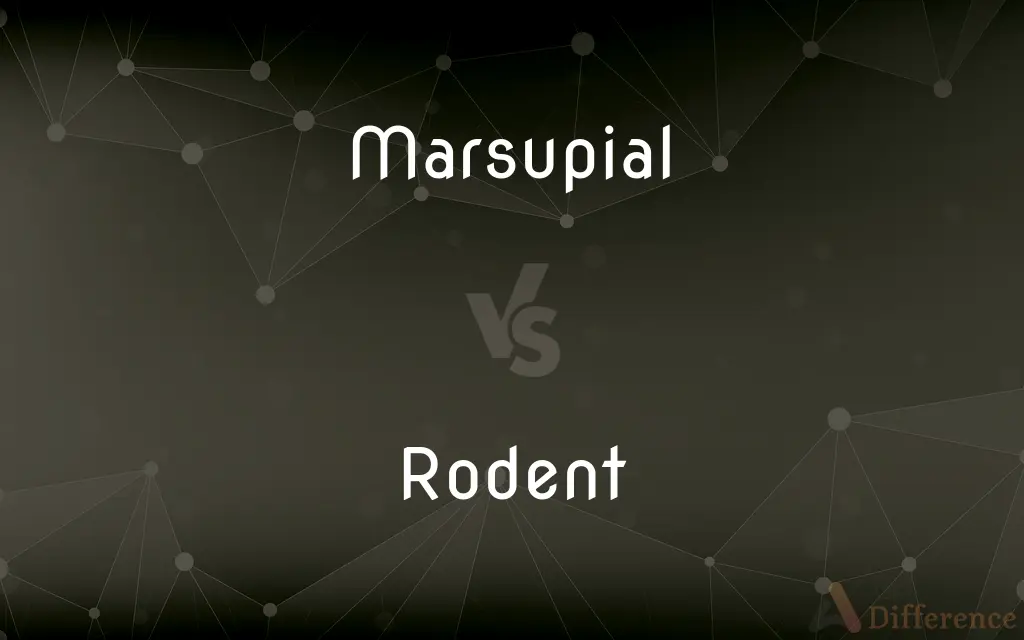Marsupial vs. Rodent — What's the Difference?
Edited by Tayyaba Rehman — By Fiza Rafique — Updated on September 28, 2023
Marsupials are mammals with pouches like kangaroos. Rodents are mammals with ever-growing incisors, like mice and rats.

Difference Between Marsupial and Rodent
Table of Contents
ADVERTISEMENT
Key Differences
Marsupials are a unique group of mammals that primarily carry and nurture their young in external pouches. In contrast, Rodents are mammals characterized by a pair of continuously growing incisors in both the upper and lower jaws.
While many Marsupials are native to Australia, such as kangaroos, wallabies, and koalas, Rodents are found globally and represent the largest group of mammals in terms of species number.
Marsupials give birth to relatively undeveloped young, which continue to develop outside the womb, typically inside the mother's pouch. Rodents typically give birth to more developed young, without the need for a pouch.
Marsupials can range from small insectivorous species like the marsupial mole to larger herbivores like the kangaroo. Rodents, on the other hand, are typically smaller and are known for their gnawing habits, driven by their ever-growing teeth.
Taxonomically, Marsupials are part of the infraclass Marsupialia. Rodents, however, belong to the order Rodentia, which includes creatures like mice, rats, squirrels, and beavers.
ADVERTISEMENT
Comparison Chart
Defining Feature
Pouch for nurturing young
Continuously growing incisors
Geographic Distribution
Primarily Australia and nearby islands
Worldwide
Development of Young
Birth to undeveloped young, develops in pouch
Typically gives birth to more developed young
Dietary Habits
Varies (insectivorous to herbivorous)
Primarily herbivorous, some omnivorous
Taxonomic Classification
Part of infraclass Marsupialia
Belong to the order Rodentia
Compare with Definitions
Marsupial
A mammal that carries its young in a pouch.
The kangaroo is a marsupial known for its powerful hind legs.
Rodent
A mammal with ever-growing incisors.
The mouse, a rodent, gnawed through the wire.
Marsupial
Part of the infraclass Marsupialia.
The Tasmanian devil is a carnivorous marsupial.
Rodent
Known for their gnawing habits.
The rodent chewed on the wood to keep its teeth short.
Marsupial
Includes animals like wallabies and koalas.
The marsupial, a koala, feeds primarily on eucalyptus leaves.
Rodent
Primarily herbivorous mammals.
The rodent, a guinea pig, enjoys eating fresh vegetables.
Marsupial
Marsupials are any members of the mammalian infraclass Marsupialia. All extant marsupials are endemic to Australasia and the Americas.
Rodent
Largest mammalian order in species number.
The rodent order includes diverse species from hamsters to capybaras.
Marsupial
Any of various nonplacental mammals of the infraclass Metatheria, including kangaroos, opossums, bandicoots, and wombats, found principally in Australia and the Americas, and typically bearing young that suckle and develop after birth in the mother's pouch. These species were formerly placed in the order Marsupialia.
Rodent
Includes animals like rats, squirrels, and beavers.
The squirrel, a type of rodent, stored nuts for winter.
Marsupial
Of or belonging to the infraclass Metatheria.
Rodent
Rodents (from Latin rodere, 'to gnaw') are mammals of the order Rodentia (), which are characterized by a single pair of continuously growing incisors in each of the upper and lower jaws. About 40% of all mammal species are rodents.
Marsupial
Relating to or having a marsupium.
Rodent
Any of various mammals of the order Rodentia, such as a mouse, rat, squirrel, or beaver, characterized by large incisors used for gnawing or nibbling.
Marsupial
A mammal of which the female has a pouch in which it rears its young, which are born immature, through early infancy, such as kangaroos or koalas, or else pouchless members of the Marsupialia like shrew opossums.
Rodent
A mammal of the order Rodentia, characterized by long incisors that grow continuously and are worn down by gnawing.
Marsupial
Of or pertaining to a marsupial.
Rodent
A person lacking in maturity, social skills, technical competence or intelligence; lamer.
Marsupial
(anatomy) Of or relating to a marsupium.
The marsupial bones
Rodent
Gnawing; biting; corroding; applied to a destructive variety of cancer or ulcer.
Marsupial
Having a pouch for carrying the immature young; of or pertaining to the Marsupialia.
Rodent
Gnawing; biting; corroding; (Med.) applied to a destructive variety of cancer or ulcer.
Marsupial
Of or pertaining to a marsupium; as, the marsupial bones.
Rodent
Gnawing.
Marsupial
One of the Marsupialia.
Rodent
One of the Rodentia.
Marsupial
Mammals of which the females have a pouch (the marsupium) containing the teats where the young are fed and carried
Rodent
Relatively small gnawing animals having a single pair of constantly growing incisor teeth specialized for gnawing
Marsupial
Of or relating to the marsupials;
Marsupial animals
Marsupial
Gives birth to undeveloped young.
The marsupial's newborn continued its development in the pouch.
Marsupial
Primarily found in Australia.
The marsupial fauna of Australia is diverse and unique.
Common Curiosities
Which has continuously growing teeth?
Rodents.
Where are marsupials primarily found?
Mostly in Australia.
How do marsupial babies develop?
Primarily in their mother's pouch.
What's the primary habitat of marsupials?
Varied, but many are native to Australia.
Are kangaroos marsupials or rodents?
Kangaroos are marsupials.
Do all rodents have a pouch?
No, only marsupials have pouches.
Which is larger in species number?
Rodents.
Are beavers considered rodents?
Yes, they are.
Why do rodents gnaw constantly?
To keep their ever-growing incisors in check.
What's a well-known marsupial from Australia?
The koala.
Share Your Discovery

Previous Comparison
Praxis vs. Practice
Next Comparison
Meta vs. BetaAuthor Spotlight
Written by
Fiza RafiqueFiza Rafique is a skilled content writer at AskDifference.com, where she meticulously refines and enhances written pieces. Drawing from her vast editorial expertise, Fiza ensures clarity, accuracy, and precision in every article. Passionate about language, she continually seeks to elevate the quality of content for readers worldwide.
Edited by
Tayyaba RehmanTayyaba Rehman is a distinguished writer, currently serving as a primary contributor to askdifference.com. As a researcher in semantics and etymology, Tayyaba's passion for the complexity of languages and their distinctions has found a perfect home on the platform. Tayyaba delves into the intricacies of language, distinguishing between commonly confused words and phrases, thereby providing clarity for readers worldwide.
















































